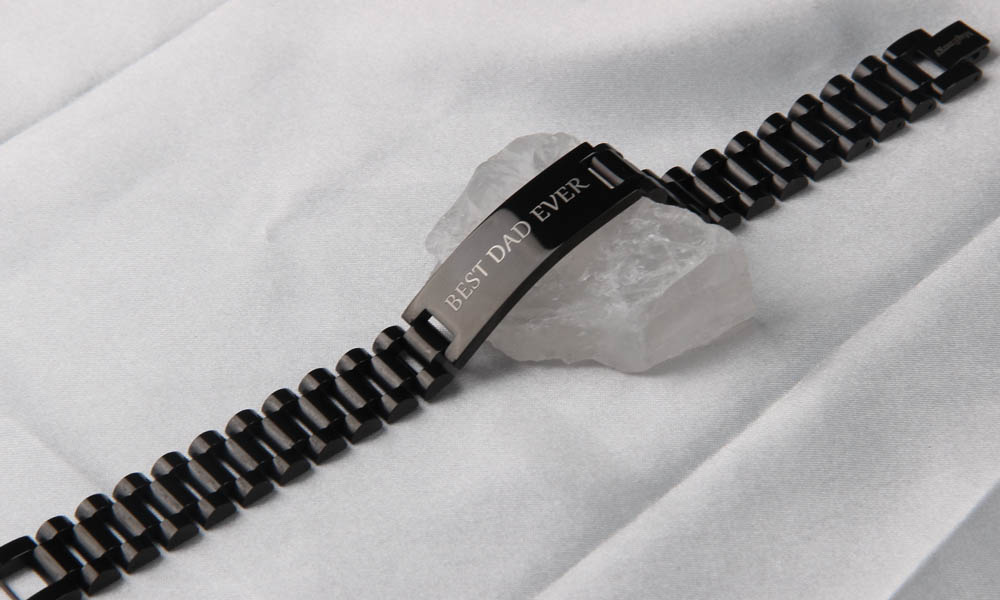Stainless steel, a metal alloy, is made up of elements such as chromium and iron. It is durable and non-corrosive, meaning it won’t fade. It is used to make kitchen utensils, surfaces, and many pieces of jewelry.
Why Choose Stainless Steel Jewelry?
Here are a few reasons I would suggest you choose stainless steel jewelry:
- Hypoallergenic
This means it will not cause an allergic reaction, you can wear it safely. Unlike gold and silver, you don’t have to worry about stainless steel jewelry triggering a flare-up, as it contains no impurities.
- Good corrosion resistance
Stainless steel jewelry will not rust or corrode even in seawater/ marine environments.
- High Specific Strength
It’s durable enough to hold for a long time. Tensile strength of approximately 621 MPa or 90 KSI, melting range of 2,500 – 2,550 °F or 1,371 – 1,399 °C.
- Easy to maintain
There is no hassle involved in the maintenance process. You simply need dishwasher detergent, warm water, and a soft cloth, and you’re good to go. Over time, I suggest you invest in a professional polishing agent.
- Multi-Finish Luster
Available of Mirror finish, Brushed finish, Satin finish Matte finish, Bead blast finish, and more
- Various Styles
There is much technology to make out stainless steel jewelry, such as stamping, casting,wire-electrode cutting, and lathes to make different shapes and patterns.
- Environmental Friendly
Who doesn’t love the environment? I know I do. Not many people know this, but stainless steel jewelry is eco-friendly. Jewelry manufacturers save on non-renewable sources by avoiding the use of too much primary energy. In addition, there is less waste from the manufacture of stainless steel jewelry.
So, should you try stainless jewelry you might ask? Well, I would give it a solid yes.

Stainless Steel types for jewelry
In general, when talking about jewelry, there are two types of stainless steel used. They’re grade 316 and grade 304. Let’s talk a little about the two.
Grade 304
This grade of stainless steel, also known as 18-8 stainless steel, is commonly used in jewelry making. It is composed of 18-20% Chromium (Cr) and 8-10.5% Nickel (Ni). It is generally nonmagnetic but can develop a small magnetic field after cold working (bending, rolling, stretching).
It has anti-corrosion proprieties because of the nickel-chromium alloy. Hence, it is used in jewelry making. Some variants of stainless steel 304 include 304N, 304H, and 304L.
Grade 316
You can view Stainless steel grade 316 as an upgraded version of 304. It is produced by adding an extra element to the mix, Molybdenum (Mo). This gives the metal an added buff to its corrosion-resistant property.
Comparing the two grades of stainless steel, Grade 316 is superior in heat resistance, corrosion resistance, and other areas. Undoubtedly, you can agree that Grade 316 is a good choice when it comes to jewelry.
There is a special variant of grade 316, which is 316L. The “L” means that the carbon content of the alloy is below 0.03% which makes the 316L stainless steel sheet preferable for welding.
Specification of 316 and 316L
| Grade | C | Mn | Si | P | S | Cr | Mo | Ni | N | |
| 316 | Min/Max | -/0.08 | -/2.0 | -/0.75 | -/0.045 | -/0.03 | 16.0/18.0 | 2.0/3.0 | 10.0/14.0 | -/0.1 |
| 316L | Min/Max | -/0.03 | -/2.0 | -/0.75 | -/0.045 | -/0.03 | 16.0/18.0 | 2.0/3.0 | 10.0/14.0 | -/0.1 |
What is the best stainless steel for jewelry?
When choosing the right material for jewelry, you will have to consider a variety of aspects, the main characteristic being the grade of the material.
As we have discussed earlier, there are two major grades of stainless steel used in jewelry, 304 and 316. Grade 316L is the better material as it relates to its properties and hence, the best stainless steel for jewelry.
What is the color of stainless steel jewelry?
Stainless steel in its original form is silver in appearance. However, for fashion and individual taste, you can find stainless steel jewelry in a variety of colors such as rose gold, gold, black, blue, etc. The coloring/plating method used is PVD-plating.
So, if you have a personal choice of color, then it can be arranged.

How to clean stainless steel jewelry?
How to clean and care for stainless steel jewelry?
If you’re looking for a simple method to clean your stainless steel jewelry, I have one for you.
1) Get two small bowls of water.
2) Add mild dish soap to one bowl, two or three drops.
3) Dip the edge of a soft cloth in the soap mixture.
4) Gently rub the jewelry.
5) Rub any grime away with a soft-bristle toothbrush.
6) Rinse the jewelry in the second bowl of water.
Disadvantages of stainless steel jewelry
1) Limited Designs: Due to its inflexible and rigid nature, stainless steel is not easy to work with. That’s why there are limited options on the market.
2) Resize issues: Stainless steel is rigid and inflexible making it hard to resize. This is especially true for jewelry that needs to be fitted such as anklets, rings, and bracelets. Even if resizing is possible, the jewelry’s original look might be altered.
3) Tend to develop dents – This is not so much of a con as it is subject to how you care for the jewelry. Although stainless steel is durable, like any other metal, it is susceptible to denting if used carelessly.
4) Non-hypoallergenic – While there is a small percentage of nickel present, it can still irritate sensitive individuals. However, if you still desire to try it, I recommend wearing jewelry made with surgical stainless steel (hypoallergenic).

FAQ on stainless steel jewelry
1) Can you bathe or shower with stainless steel jewelry?
Yes, you can shower with the jewelry as water will not cause damage. This is because of the chromium present which prevents corrosion. One thing I would recommend is drying the jewelry afterward to prevent any possibility of corrosion.
2) Does stainless steel turn finger green?
The green color, fougerite, is a rust mineral from metal corrosion. Under normal circumstances and usage, it is highly unlikely to happen.
3) Does stainless steel jewelry tarnish or rust?
Corrosion and rusting are inevitable. Stainless steel, while being rust-resistant, is not rust-proof. However, under normal use, stainless steel jewelry will not tarnish or rust for quite a while.
4) Can stainless steel be colored?
Yes, you can plate color stainless steel using four basic methods: Electroplating, PVD/IP plating, Oxidization/Anodizing, and Bath dipping. Using these methods, the color of stainless steel jewelry can range from gold (14k, 18k, 24k, and rose gold), to blue, to black, dark grey, and even silver/titanium.
Electroplating can be used to create a variety of vivid colors. However, it is less durable.
All our stainless steel jewelry with PVD plating which keep at least 2 years no discolor.
5) Is Stainless Steel Jewelry Safe to wear?
You don’t have to worry about being poisoned while wearing stainless steel jewelry, as it contains the least toxic chemicals. In addition, low quantities of nickel are used, which makes the jewelry less prone to cause skin irritation.
Final Thoughts
After this reading, I believe you would’ve fully understood everything that you needed to know about stainless steel jewelry.
It’s elegant, affordable, durable, corrosion-resistant, and easily accessible. The better the grade, the better the qualities. If you still have questions, feel free to contact me at biomagneticjewelry.com . All the best!


